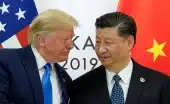Molly Minturn - My family is heartbroken to share that my father died in surgery on Monday, Feb. 10. It…
Wednesday Night #811 – Mexico
Written by Diana Thebaud Nicholson // September 17, 1997 // Herb Bercovitz, Reports, Wednesday Nights // 3 Comments
17 September 1997
The eight hundred and eleventh consecutive Wednesday evening (see photos and back-up info) at the Nicholsons’ was an unusually dynamic and educational one, thanks to the three special guests who provided exciting and informative dynamism, stimulating fascinating conversation that electrified all present.
Sonia Saumier de Bueno and her husband, Gerardo Bueno y Zirión, O.B.E were in Montreal from Mexico. and, with Sonia’s brother, André, joined us.
Gerardo was here to speak on the future of the Pulp and Paper industry, but on Wednesday evening, he brought us up to date on events in Mexico, the effects of NAFTA and the broad economic outlook for his country.
Gerardo graduated in Economics from Yale and is currently a Senior Fellow at the College of Mexico. He was the Director General of Conacyt (the Mexican National Council for Science and Technology – holding the rank of Minister); he also served as Ambassador of Mexico to The European Communities, Belgium and Luxembourg.
He negotiated the NAFTA on behalf of Mexico, has written many books and articles on International Economics, Science and Technology, founded and was Director of the US-Mexico Foundation for Science, etc., and is now, among other things, Vice-Chairman of Actinver (A Mexican investment Corporation).
His great uncle was the first “Democratic” President of Mexico, Francisco Madero.
For those of you who do not yet have the good fortune to know Sonia, suffice it to say that her credentials and career are almost as impressive as Gerardo’s. From Expo 67 to the National Arts Centre, Transport Canada, OECD, Canadian Ministry of Industry, Science and Technology, Department of Science and Technology of the Pan American Union.
Señor Bueno y Ziriòn traced some of the dramatic political, industrial and economic changes that have taken place leading up to and since NAFTA. It was evident from the video clips which introduced the topic that these exciting developments have thus far, unfortunately escaped the notice of the North American media, who continue to prolong old outmoded stereotypes.
This dramatic opening stimulated compelling discussions on a variety of topics.
Changes since pre-NAFTA period:
Mexico had always related to Central America rather than North America, which had been perceived more as a threat than an ally. The North American Free Trade Agreement which was not originally supported by opposition parties, has since gained the support of all parties. Mexico is moving very rapidly into the North American model with all its advantages and all of its faults. The result of the next federal election is unpredictable at this point, but considering the changes that have taken place in Mexico, even if the ruling PRI (Partido Revolucionario Institucional) is overturned, not one of the parties currently in opposition is prepared to terminate the agreement.
At first, Mexico was not certain that it wanted the inclusion of Canada, but ultimately realized that the Canadian-Mexican influence served as a counterbalance to the overwhelming size and influence of the United States.
Since signing of the agreement, events have moved very rapidly. Since NAFTA, Canada-Mexico trade has doubled. Trade between the two countries has exceeded trade between Mexico and all Latin America, and between Mexico and Japan, amounting to close to two hundred billion dollars per year. Mexico is on the road to recovery, with 4% growth in the economy, inflation is down. A zero percent population growth is expected. Decentralization of the industrial sector is being encouraged through the elimination of subsidies to the Mexico City area. This is a difficult task to achieve because of the influence of industrialists and politicians from Mexico City. The fear of job losses in Mexico, United States and Canada have not materialized. There is now more balanced trade with very little impact if any, on employment figures.
The only negative aspect is the variable nature of quality and delivery in some industries. New modern plants produce superior merchandise at low cost. Growth has been so rapid that reliability varies from industry to industry. This situation is not unlike the economy of Japan half a century ago, and possibly poses hope for a trajectory similar to that of Japan.
Not only has NAFTA resulted in increased trade, but cultural, scholarly and academic exchanges between Canada and Mexico have increased tremendously, expanding and cementing the results of the trade agreement.
Environmental Concerns
NAFTA was linked to environmental issues, to address common environmental issues and encourage better enforcement of environmental laws. Mexico is currently a leader in environmental awareness. Unfortunately recent economic conditions have imposed a temporary setback to this initiative, but this will change in the near future. Mexico is rebounding and building for the future.
Vietnam
Canada, through a Canadian International Development Agency (CIDA) project is helping the Vietnamese government transform from a central economy to a market economy. Vietnam is pursuing the Chinese rather than the U.S.S.R. model, that is a gradual liberalization of the economy while retaining a one-party political system as opposed to throwing out an established system and replacing it with chaos. All communications media are still controlled by the government. The secret police is very active. Liberalization comes in fits and starts. Unlike the U.S.S.R., North Vietnam has embraced communism since 1945, and the south since 1975. The south has proceeded with reform at a faster rate. It is essentially the first generation of communists that remains in control and has had a longer run in the north. The reform is driven more by necessity than liberalization. When the U.S.S.R. collapsed in 1989, foreign trade with the eastern block suddenly started requiring payment in hard currency instead of the sort of barter system that had previously existed. This conflict “between head and heart” resulted in terrible inflation and hardship. Health services have deteriorated, profits are low, and goals and objectives continue to be controlled centrally.
Communications
A worldwide revolution is taking place in communications, to the detriment of High Density Television. Digital transmission is replacing the older analog system in Europe and in North America.
Drug Trafficking:
Producing countries are frequently criticized for their part in drug trafficking. Figures indicate that only five percent of the street price goes to the grower, twenty percent to the trafficker and the remainder to the cartels in the developed user countries. Solutions to the problem probably require rethinking, keeping in mind these facts.
The Stock Market
Following a seven percent correction, the market is once again on the upswing. The Dow Jones is likely to exceed 8000 in the near future, and the Toronto Stock Exchange will reach a new high. The dollar is recovering, inflation is low and unemployment is high, thus a tight money policy is unlikely for Canada. We still own 3.1 million ounces of gold after selling off about half our gold reserves. We have built up our international reserves to about twenty billion dollars of which eighteen billion is in U.S. dollars. Profits remain high, inflation is low. The future looks good for Canada.
The message is, “Watch 1998”
The Canadian Economy
Interest rates are stable and will continue to remain so in the foreseeable future, the economy will continue to rise by 4%, there is no pressure on inflation. The Canadian trade surplus is not as great as anticipated however because of our low interest rates which cause money to be heading to the United States, keeping the Canadian dollar low.
Despite the undervalued Canadian dollar, our trade surplus is not as great as anticipated. It was suggested that one reason for this is that Canada has been unwilling to bend the rules in seeking foreign contracts by, for example, subsidizing the financing of contracts in trades with foreign purchasers such as China. Canada is unlikely to support the Canadian dollar unless it falls below seventy-two cents U.S.
The outlook is very rosy for the Canadian Economy. The situation is similar to the 1950’s, with similar inflation and interest rates. The baby boom bulge has now passed and we are on the verge of a period of expansion similar to that of the ’50s.
A Common European Currency
There is grave doubt that this will be achieved. The most obvious reason for this is that in losing its currency, a country loses a great deal of its decision-making ability. There is in addition however, a very serious technical problem. The European Economic Community is not a logical currency area. There is at most a group of about six or seven countries that might, and probably will go ahead with a common currency. These include the Benelux countries, Germany and possibly Italy.
As an aside, the opinion was expressed that if Québec ever became sovereign, it would find it impossible to avoid creating its own currency. Québec has projected a balanced budget, but unlike Alberta and Ontario, it will have achieved this not by cutting the bureaucracy but by displacing the burden to municipalities and educational, health and social service institutions. This is the only government not to go through a real downsizing. It was pointed out that for instance, the insistence that public and parapublic agencies pay for the liberation of union officials to attend meetings has cost the taxpayer about fifty million dollars a year. The civil service has hardly decreased in number. In Québec, the civil service has become a sacred cow, totally entrenched, impermeable to attack by any political party.
The Impending Crash: Imminent or Distant?
Two views- A number of conditions exist in to-day’s world economy, including:
Unemployment in Europe is 12%, in U.S. 4%
Interest rates are very low
Banks are merging and talking about merging
Personal credit is very high
Corporations are flush with cash
First Scenario:
These conditions duplicate those in 1929. BEWARE OF OCTOBER 1997.
Second Scenario:
These conditions duplicate those in 1895. We can look forward to steady growth for the next thirty-four years with only minor glitches and corrections. The reader is invited to select the appropriate scenario, as did the Wednesday Night guests, or to create their own.




3 Comments on "Wednesday Night #811 – Mexico"
September 16, 1997 Long-awaited revival of Loonie slow in coming Canadian dollar is as much as 15 per cent more than the 72 cents U.S. you can actually get for it. Loyd Atkinson expects to see the dollar at 78 cents by the end of next year
September 19 Bank of Canada will soon raise interest rates to curb growth and boost the dollar
September 19 …Canadians may need visas to enter the U.S.!?
September 20, 1997 Bank of Canada’s stern warning this week that rock-bottom interest rates will come to an end pretty soon.
Mr Paragon’s US stock portfolio Managed by Larry Davis and David Nicholson and seen in ‘THIS WEEK IN BUSINESS’ until the paper went under, then untouched for seven years is up 215% Div/income not included!
Conditions duplicate those in 1929. BEWARE OF OCTOBER 1997